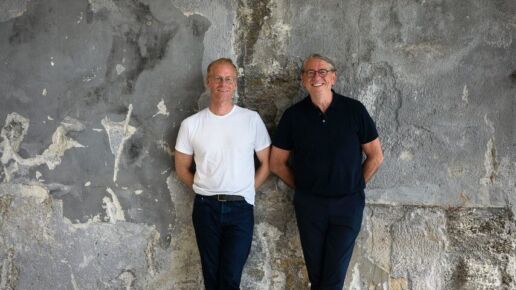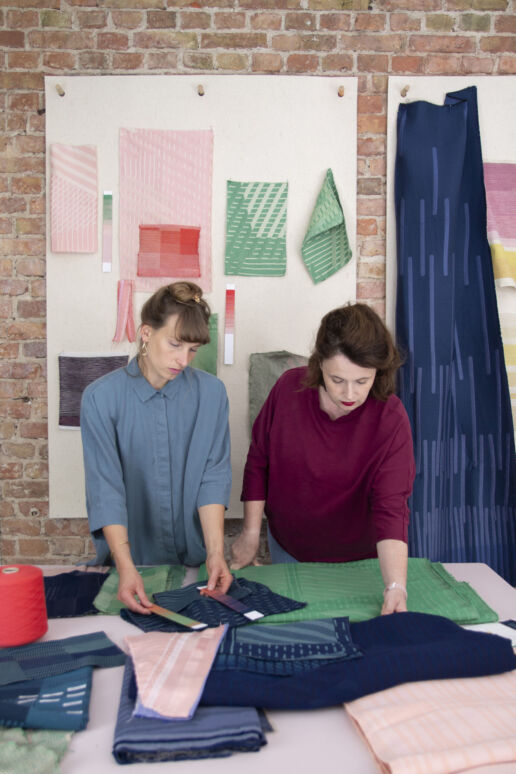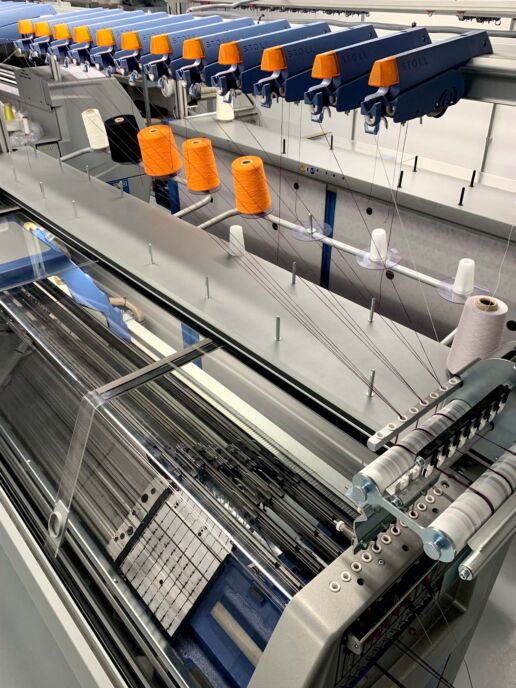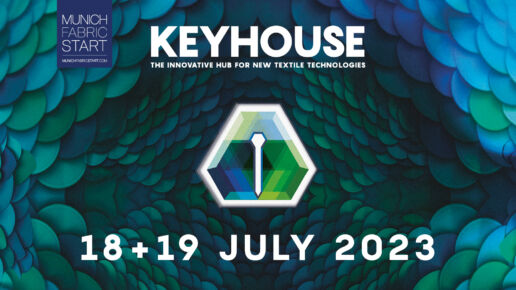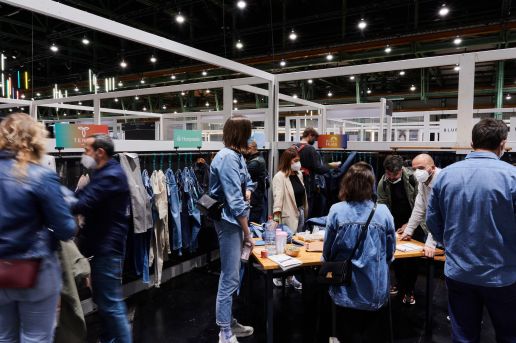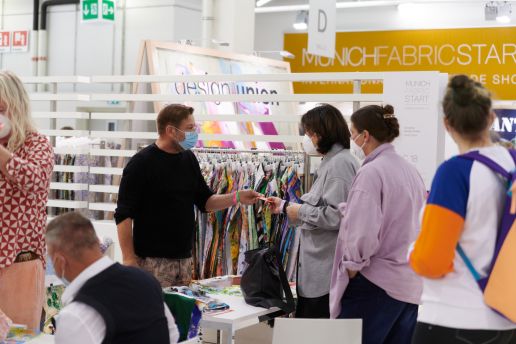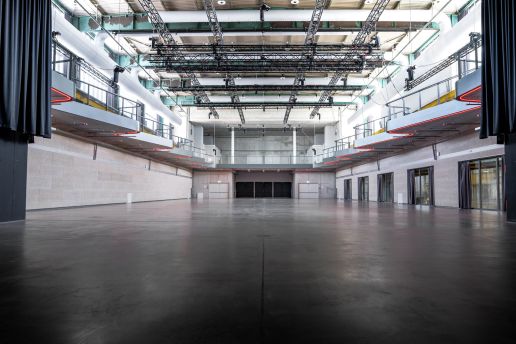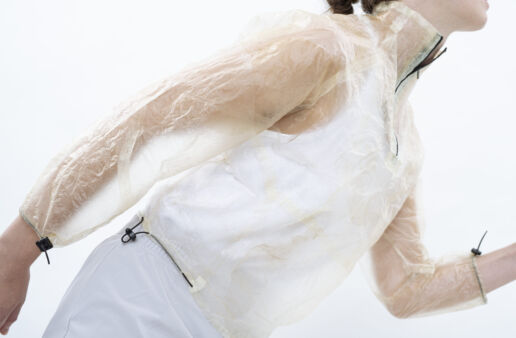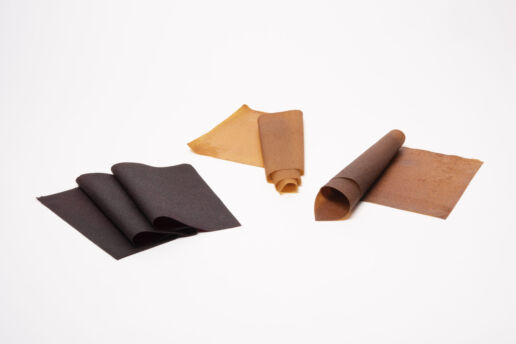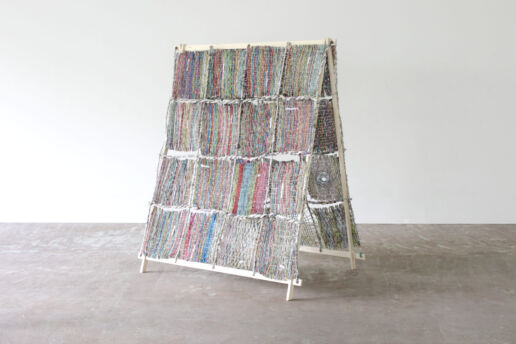Sustainable Innovations
Circularity is key - Sustainable Innovations
From old to new: Pre-Loved is a biotextile concept in which new products are created from used post-consumer textile waste. In a unique production process, low-quality mixed textile fibres are transformed into a robust, paper- and leather-like material that is suitable for a variety of applications – from fashion to interior design and product design.
Designer Sarmite Polakova gives waste a new meaning in this context: instead of something negative, she perceives it as a surplus recyclable material that can, however, at the same time be a resource for the creation of something new – the focus here is on circularity: it is about the recyclability of the material; a product made by Studio Sarmite can be dissolved at the end of its life and the textile fibres can be used for the next production cycle. The lightweight material displays a processuality, revealing a new aesthetic and highlighting each previous life of a worn garment through nuances of colour and texture. It can feature marble-like patterns as well as hues accentuated by natural dyes.
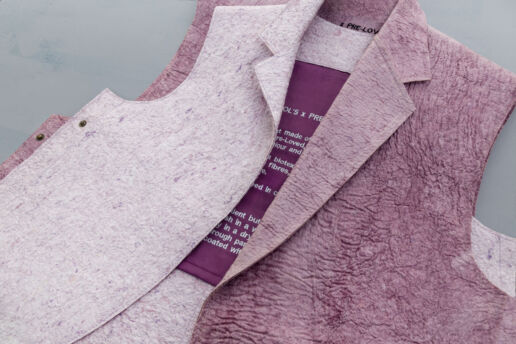
“The term ‘waste’ should be seen as a surplus rather than something negative and thus can be turned into a resource for creating something new.”
SARMITE POLAKOVA
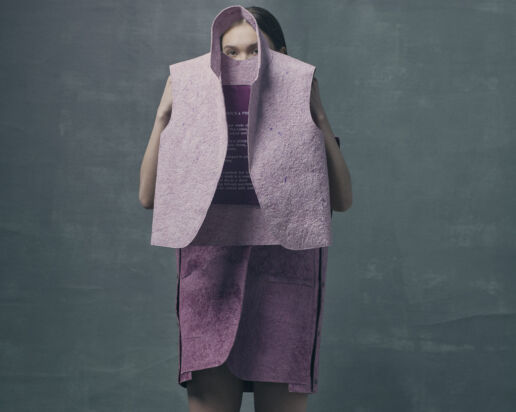
Cooperation is key – first Sarmite Polakova of Studio Sarmite teamed up with colour specialist Roua Alhalabi of Roua Atelier. The result of the collaboration is a groundbreaking dyeing method for blended fabrics based on natural pigments. The dyeing process is integrated into the production of the organic biotextiles and leads to a unique design language that gives room for surprising patterns and a certain playfulness. Moreover, the two designers have found a way to extract the dye during the recycling process of the textiles and use it for the next life cycle without the need for additional resources.
“Nature gives us a lot of resources that can be used in the natural dye industry. In fact, everything around us can be used to make color and support new materials. By using eco- riendly materials, we can become more sustainable and make a good impact.”
ROUA ALHALABI
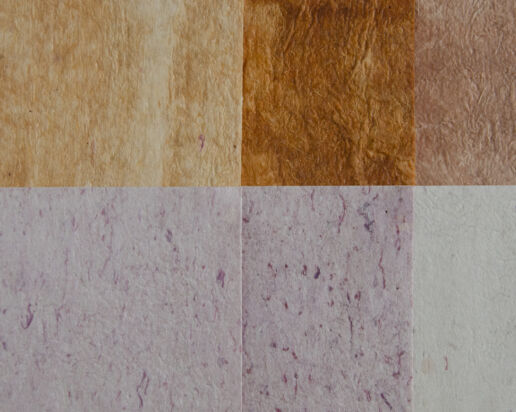
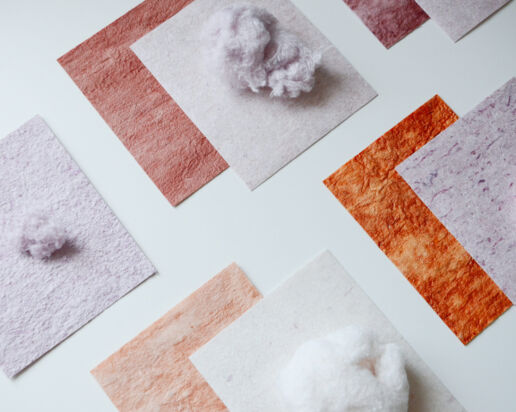
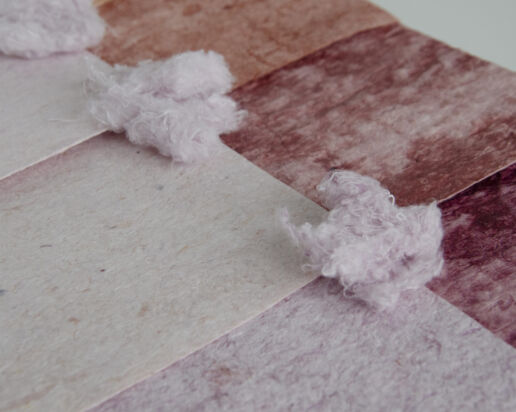
———————————————————————–
THIS ALSO MIGHT BE INTERESTING FOR YOU
Navigating the Future of Sustainable Innovation
3. September 2024
This season, we're continuing this saga by posing critical questions and embracing a more holistic narrative. It’s less about solutions and more about interventions and transformative thinking.
INTUITION – In conversation with the organisers of MUNICH FABRIC START about the zeitgeist, trade shows and new chances
3. September 2024
INTUITION means that we have the courage to rely on our inner voice instead of just relying on hard facts and data. An interview with the organisers of MUNICH FABRIC START.
FABRIC HIGHLIGHTS & MATERIAL NOVELTIES FOR AUTUMN.WINTER 25/26 – PART VIII
3. September 2024
The claim “The best made by our hands” highlight the importance of our partners to create an high quality fabric giving the best service possible.
Next Generation Material - Sustainable Innovations
Bio-based, locally produced, on demand: that’s MYCOTEX by NEFFA – a flexible material whose properties lie somewhere between leather, plastic and artificial leather. Production takes place in three steps: First, customisable and/or recyclable forms are created in an automated 3D design process. With the help of liquid fermentation, innovative materials are produced – the technique works for mycelium, but is also suitable for other biomaterials. In the end, the final textiles are produced by robotic applications without any weaving, cutting or sewing. In this way, the modelling process is similar to the injection moulding process – except that only natural materials are used instead of plastics.
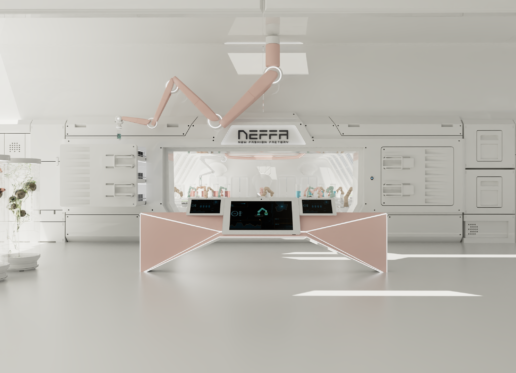
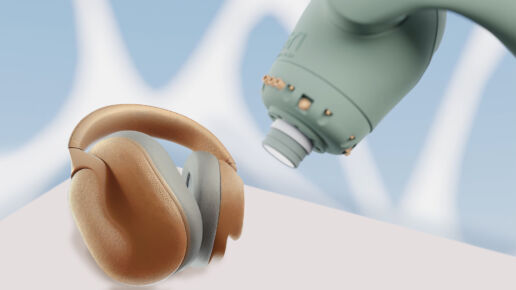
In leather production, the most resource-intensive factors are the land required for animal husbandry, the consumption of water for tanning, the energy required and the CO2 emissions. It is precisely in this production chain where MYCOTEX comes into play: Resource-saving robotic applications can save 10 to 30 percent of waste, and in addition, the production of materials and products takes place directly on site, so there are no emissions for transport. The textiles are biodegradable and can even be composted at home.
More than Mycelium: At the beginning of the project, founder Aniela Hoitink focused in particular on the material MYCOTEX. Within the last three years, this has developed into NEFFA, a completely automated manufacturing method for different types of biomaterials. NEFFA stands for New Fashion Factory. The innovative system is based on automation, can be recycled and offers unlimited freedom of design. The patented process offers unprecedented design freedom to create silhouettes and textures that would never have been possible with traditional manufacturing methods and creates a local and completely transparent process that can be adapted to constant changes. For the textiles of tomorrow.
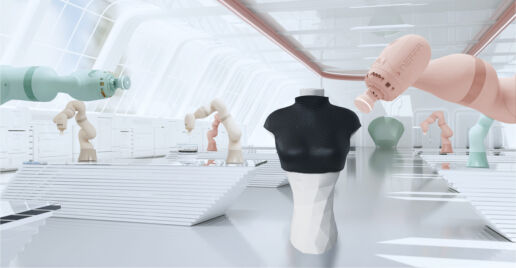
“The fashion and textile industry is working on steps to improve: material innovation, better dyeing processes, a reduction of water, quick fixes that are needed right now. This will not be enough in the future. We need a big step to transform the industry. And we need it to be local, with a better working environment and without waste.”
ANIELA HOITINK
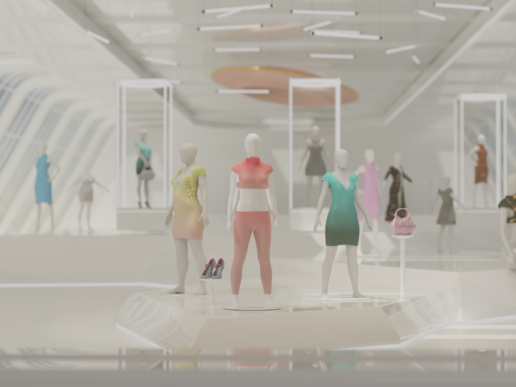
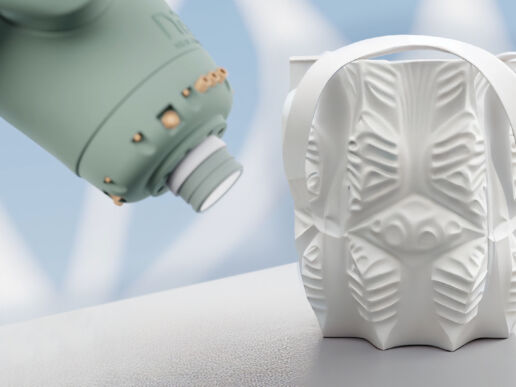
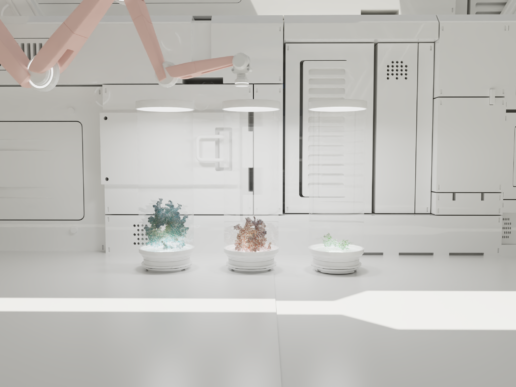
———————————————————————–
THIS ALSO MIGHT BE INTERESTING FOR YOU
Navigating the Future of Sustainable Innovation
3. September 2024
This season, we're continuing this saga by posing critical questions and embracing a more holistic narrative. It’s less about solutions and more about interventions and transformative thinking.
INTUITION – In conversation with the organisers of MUNICH FABRIC START about the zeitgeist, trade shows and new chances
3. September 2024
INTUITION means that we have the courage to rely on our inner voice instead of just relying on hard facts and data. An interview with the organisers of MUNICH FABRIC START.
FABRIC HIGHLIGHTS & MATERIAL NOVELTIES FOR AUTUMN.WINTER 25/26 – PART VIII
3. September 2024
The claim “The best made by our hands” highlight the importance of our partners to create an high quality fabric giving the best service possible.
Drawn by the sun - Sustainable Innovations
Textiles as witnesses of time: SLOW PATTERNS is a collection by the Berlin studio Meyers & Fügmann that changes over time due to the influence of sunlight. This works by using an unconventional technique that combines the natural and the artificial. In concrete terms, this means that European is woven and dyed in Europe by hand, with the side effect of preserving traditional skills of the European textile industry. The collection combines wool with synthetic yarns. When the textiles are exposed to UV light, the natural dyes fade over time, while the stable synthetic colours retain their shades, changing the materials and eventually revealing delicate patterns.
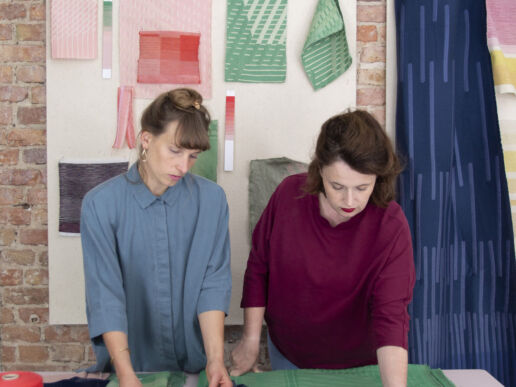
The textiles have the peotic power of tracing time. The changes in the colours make the ageing process visible and make transience a subject of discussion – spiritual as well as material. Seeing the textiles develop creates an emotional relationship, as both the owners and the objects age side by side. The textiles thus reflect and make transience visible. In doing so, they raise questions about physical obsolescence. Instead of connoting these aspects negatively, SLOW PATTERNS encourages us to value the products over their entire lifespan and to accept and celebrate their changes as well as our own.
A sign against fast fashion: the low lightfastness of natural materials is often seen as a shortcoming. Meyers & Fügmann, on the other hand, show with their project how aesthetically natural colours change and that beauty can lie in this process. SLOW PATTERNS thus becomes a plea for the dignity and vitality of natural colours.
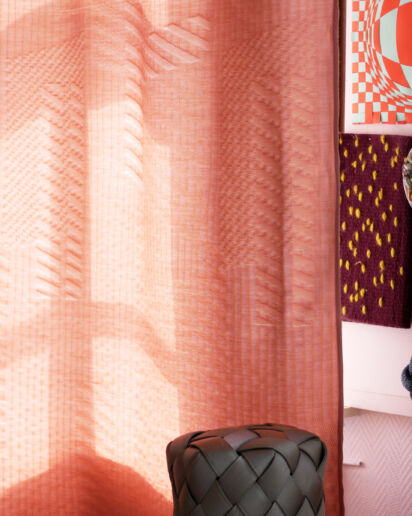
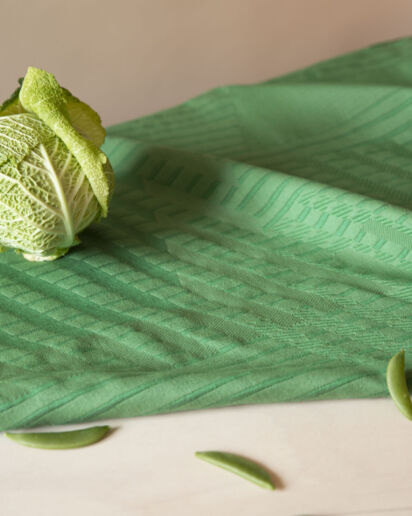
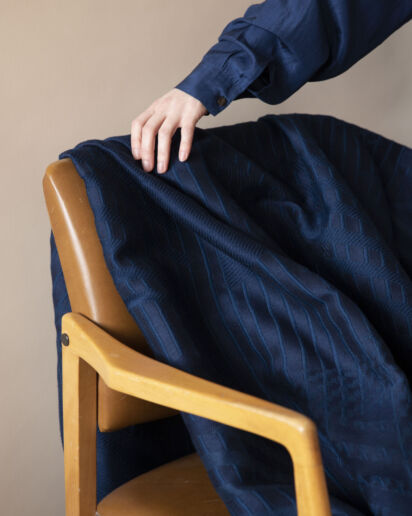
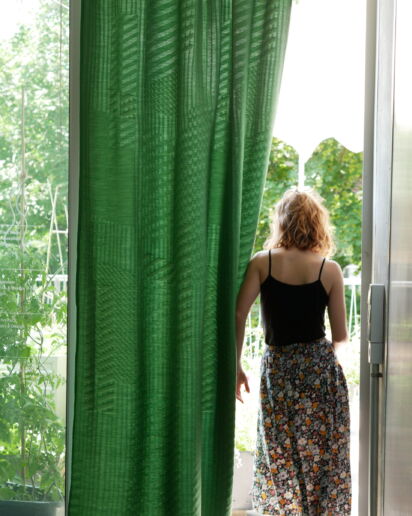
“Lightfastness is a relevant topic for future industries, as natural and recycled dyes and fibers demonstrate lower lightfastness.
Our approach is to show the liveliness of natural colours and romote them as a real alternative to synthetic dyes, opening markets for less durable colours. The aging process is designed into the product in order to foster a debate about slow consumerism and the relationship we have with our belonging.”
SARAH MEYERS AND LAURA FÜGMANN
———————————————————————–
THIS ALSO MIGHT BE INTERESTING FOR YOU
Navigating the Future of Sustainable Innovation
3. September 2024
This season, we're continuing this saga by posing critical questions and embracing a more holistic narrative. It’s less about solutions and more about interventions and transformative thinking.
INTUITION – In conversation with the organisers of MUNICH FABRIC START about the zeitgeist, trade shows and new chances
3. September 2024
INTUITION means that we have the courage to rely on our inner voice instead of just relying on hard facts and data. An interview with the organisers of MUNICH FABRIC START.
FABRIC HIGHLIGHTS & MATERIAL NOVELTIES FOR AUTUMN.WINTER 25/26 – PART VIII
3. September 2024
The claim “The best made by our hands” highlight the importance of our partners to create an high quality fabric giving the best service possible.
Smart Knitting - Sustainable Innovations
When the programmers of KNITWEAR LAB teamed up with 3D software specialists, a completely new idea for more sustainable, cost-efficient and design-oriented pattern development and knitwear production emerged. By combining virtual and material knitting, it is possible to reduce the massive waste during the pattern and pre-production phase in the industry and to further advance knitwear development with the help of smart technologies. Knitting on a new level: The revolutionary aspect of the method is the combination of innovative-virtual 3D technology with classic-conventional knitwear. The virtual design can be implemented exactly as you see it, while the actual knitted fabric that you perceive haptically and visually can be virtualised exactly as it was knitted.
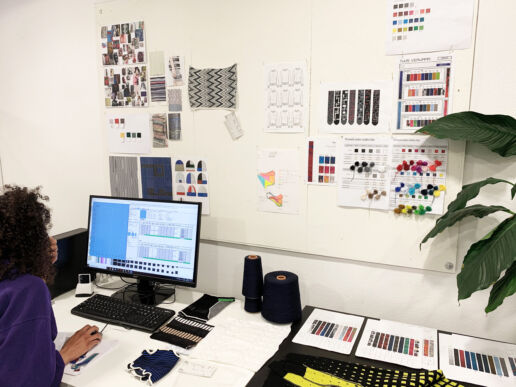
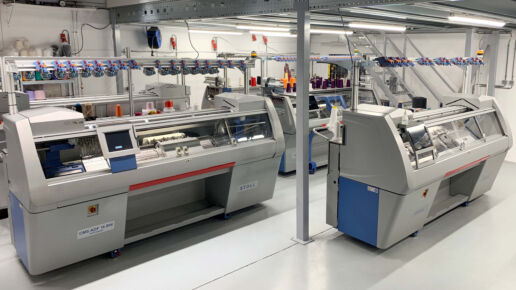
When knitting meets 3D software, there are several advantages. Designs can be improved and adjusted at an early stage in terms of design process or colouring to efficiently create virtually producible and realistic prototypes. In addition, the combination of knitwear and digital visualisation offers enormous savings potential: the waste of materials, resources and transport can thus be reduced. Furthermore, the fits for sampling and production are more accurate through Virtual Knitting, which is why, ideally, fewer samples need to be produced. Last but not least – the method significantly shortens the time from design to market and enables early commercial validation of the products, thus offering a win-win in the aspects of economic and ecological sustainabilit.
“A revolutionary method for industrial knitwear development:
A connection between virtual and material(physical) knitting, which creates a whole new world for sustainable, cost-efficient and design-driven sample development and knitwear production. KNITWEAR LAB will reduce the massive waste during the sample and pre-production stage in the industry with the use of extensive knitwear knowledge of the programmers of KNITWEAR LAB combined with the newest 3D software.”
Cherish Brouwer, Co-Founder & Designer Knitwear Lab
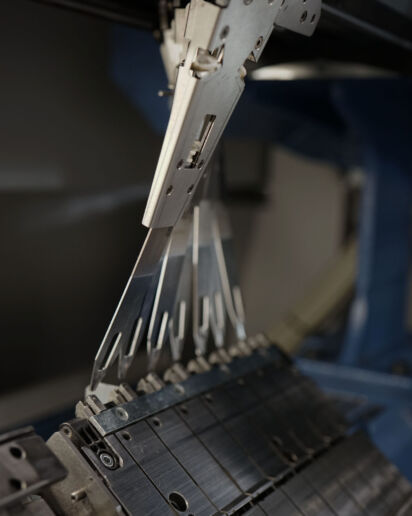
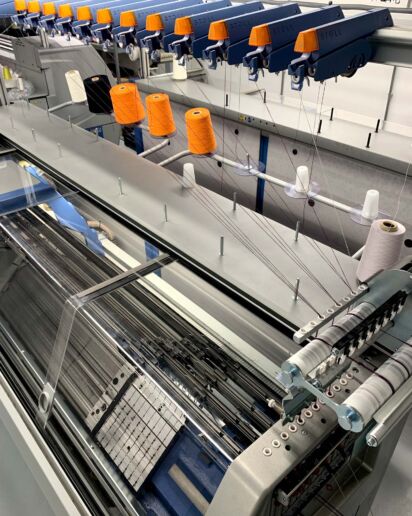
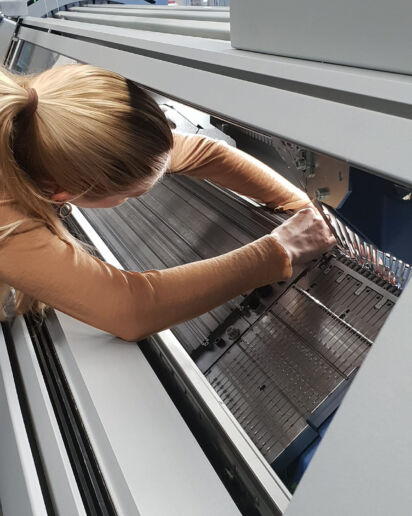
———————————————————————–
THIS ALSO MIGHT BE INTERESTING FOR YOU:
Navigating the Future of Sustainable Innovation
3. September 2024
This season, we're continuing this saga by posing critical questions and embracing a more holistic narrative. It’s less about solutions and more about interventions and transformative thinking.
INTUITION – In conversation with the organisers of MUNICH FABRIC START about the zeitgeist, trade shows and new chances
3. September 2024
INTUITION means that we have the courage to rely on our inner voice instead of just relying on hard facts and data. An interview with the organisers of MUNICH FABRIC START.
FABRIC HIGHLIGHTS & MATERIAL NOVELTIES FOR AUTUMN.WINTER 25/26 – PART VIII
3. September 2024
The claim “The best made by our hands” highlight the importance of our partners to create an high quality fabric giving the best service possible.
The clothing of the future - Sustainable Innovations
Every year, more than 120 million tons of textile fibers are processed worldwide – more than a third of them are petroleum-based synthetic fibers, i.e. resource- and emission-intensive, causing waste and polluting the environment. An alternative is needed. But: Where do the fibers for the clothes of the future come from – are textiles that grow on trees or shoes that come from the sea a pure utopia?
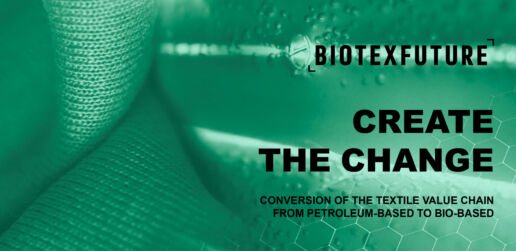
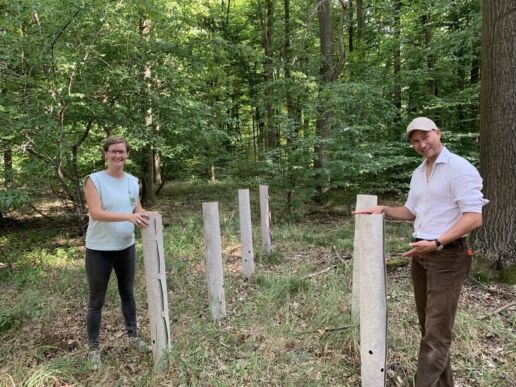
As part of the BIOTEXFUTURE Germany innovation space, leading research teams from the textile sector and industry are driving forward the development of bio-based textiles. Their aim is to accelerate the structural change towards a bioeconomy in this sector. On top of that, the ambition is also to find alternatives and solutions for some of the most important challenges currently facing the textile industry – from impregnation and dyes to elastane alternatives as well as textile recycling and microplastic filling in sports fields. On the research side, one of the world’s leading Institutes for Textile Technology at RWTH Aachen University (ITA) is responsible together with the Chair of Technology and Organisational Sociology (STO). For the industry, this part is taken over by the global company adidas AG.
Bye bye, plastic! The long-term goal is to be able to replace virgin polyester as a raw material. In concrete terms, this means that BIOTEXFUTURE is working in ten different projects to convert the individual steps along the textile value chain from petroleum-based to bio-based in the future plus to make the basic research carried out for this purpose accessible to the broad masses as quickly as possible. From algae to artificial turf to fungi: the idea behind the project ALGAETEX, for example, is to use biopolymers obtained from algae for use in textiles. BioTurf is about the development of an artificial turf structure made of bio-polyethylene that is at least as efficient as the petroleum-based materials used so far while being recyclable and without microplastic filling at the same time; the Fungal Fibers project is about the production of bio-based textile fibers from a promising fungusbased production process for the sports and medical sectors.
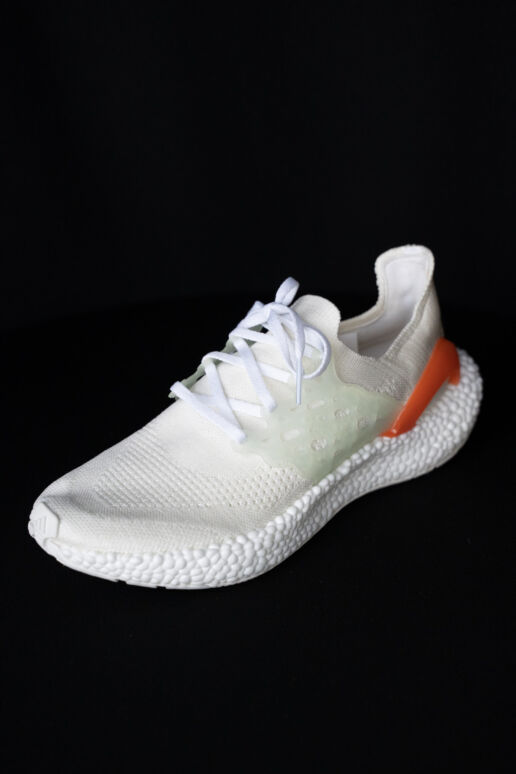
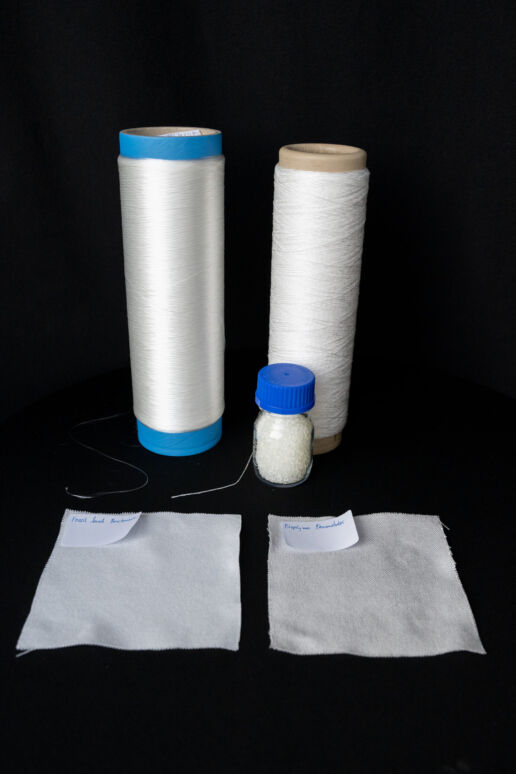
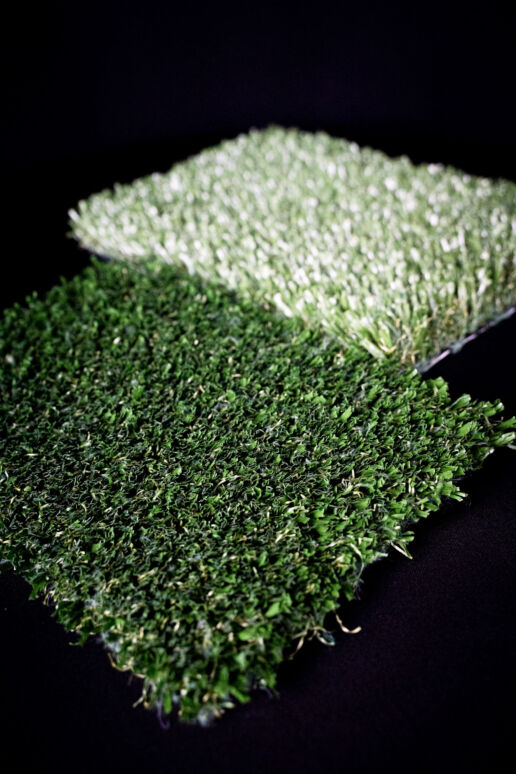
“The textile industry is not yet sustainable and burdened with massive environmental problems. Natural raw materials and ew textile technologies are a great opportunity for the future to meet the numerous challenges of the textile industry. This concerns the replacement of petroleum for polyester roduction by biological materials such as algae or fungi as well as bio-based coatings, dyes or completely new manufacturing processes. However, the major challenges of the textile sector can only be solved in close cooperation between research and industry. This is why we are committed to the BIOTEXFUTURE innovation space and would like to attract numerous new supporters in the coming years.”
Nicole Espey, Project Manager BIOTEXFUTURE
———————————————————————–
THIS MIGHT ALSO BE INTERESTING FOR YOU:
Navigating the Future of Sustainable Innovation
3. September 2024
This season, we're continuing this saga by posing critical questions and embracing a more holistic narrative. It’s less about solutions and more about interventions and transformative thinking.
INTUITION – In conversation with the organisers of MUNICH FABRIC START about the zeitgeist, trade shows and new chances
3. September 2024
INTUITION means that we have the courage to rely on our inner voice instead of just relying on hard facts and data. An interview with the organisers of MUNICH FABRIC START.
FABRIC HIGHLIGHTS & MATERIAL NOVELTIES FOR AUTUMN.WINTER 25/26 – PART VIII
3. September 2024
The claim “The best made by our hands” highlight the importance of our partners to create an high quality fabric giving the best service possible.
High-tech connection meets low-tech reconnection
Reflecting on the past and looking towards the future – what lies ahead in the sustainable fashion and innovative design industry?
There are two significant factors driving the evolution of the industry at present. Let’s begin with the first topic, which I refer to as the ‘process runway’. On one hand, the term ‘runway’ refers to the well-known fashion runway or catwalk. On the other hand, we can observe the growth of numerous companies and designers with a sustainable focus, who are maturing and becoming more professional, preparing themselves to connect and deliver. From this perspective, it becomes clear that companies and designers understand the need to continuously improve every step of the supply chain, striving for constant enhancement – what I call the process runway.
Could you elaborate on how these labels are improving and changing their production practices?
Certainly. Let’s delve into the example of Knitwear Lab, one of the exhibitors. They demonstrate how one client’s interactions have led to improved production and enhanced quality in several ways. In the past, their manufacturing process began with a rough sketch or digitally drawn idea. Subsequently, one single idea was prototyped multiple times, thus resulting in numerous samples, requiring significant time and numerous adjustments. This process was highly time and material-consuming. To streamline this process, Knitwear Lab embraced digitization. They created a variety of avatars with different size measurements and body types, providing a perfect digital replica for every body shape. With this approach, they can now experiment with more complex designs and experience the implications of different designs and special materials across all sizes, from XXS to XXL without producing supervacaneous samples, thus waste. This is crucial since the details of a finished garment can appear differently on various body sizes. Hence, they first create a digitally perfect fit and high-quality product. Once flawless digitally, it is then manufactured in reality. The benefits are numerous: customization, time and material savings, and cost efficiency – all essential sustainable considerations. Additionally, they can incorporate quality aspects. Cause after all efficient work processes and resource conservation remain significant challenges within the industry.
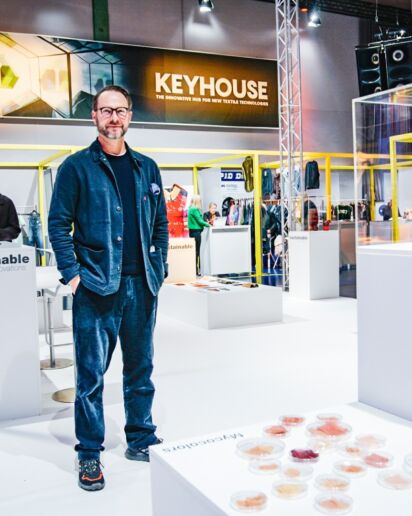
Simon Angel
So, they transitioned from specialized skills to a broader scope?
Exactly. The progression follows this trajectory: initially, we have design studios focusing on their core strengths, on what they excel at. Simultaneously, they are eager to explore avenues for improving the customer journey, sustainability aspects, sourcing or design. It entails broadening their scope of responsibilities and possibilities. Within this transition lies immense potential, but it also presents several challenges. This is the nature of pursuing a goal – people need to collaborate, assume responsibility, and expand their horizons to harness the full potential and become more sustainable and efficient.
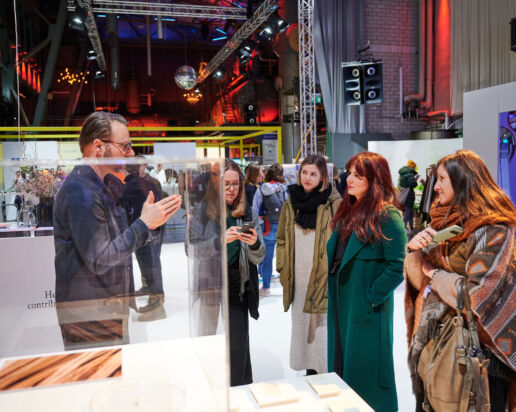
You mentioned another direction at the beginning. Could you elaborate on that?
The other topic revolves around reconnecting with craftsmanship. There is a growing focus on our human nature, on experiencing materials and products through touch, smell, taste… We are redirecting our attention towards engaging our senses. This year, we have exciting projects that facilitate this connection, inspiring people to participate in the knowledge and production processes. To be honest, this craving for tangibility and the opportunity to get hands dirty or experience materials is not limited to the production and design chain alone; it is also a fundamental human need. In the years to come, I am confident that there will be a significant resurgence in reconnecting and rediscovering the purity and authenticity of things.
Are there any synergies, or do these topics merely coexist?
On one hand we have high tech connection using digital advices for improvement and more sustainability, on the other hand low tech reconnection refocusing on craftmanship and human aspects with feeling of the senses. What they do have in common is the very important fact, that without collaboration, nothing would be the same. Studio Sarmite collaborates with Roua Atelier, Crafts Council works with Enschede Textielstad, Meyers & Fügmann cooperate with other designers. If we realize what we and others are doing, we can connect with collaboration and create something even bigger. That is what we experience ourselves at MUNICH FABRIC START: we collaborate a lot as well, for example with BiotexFuture, Berlin Design Farm and Crafts Council. We try to be a partner in acknowledging, introducing and togetherness with other partners to create something bigger in joint forces.
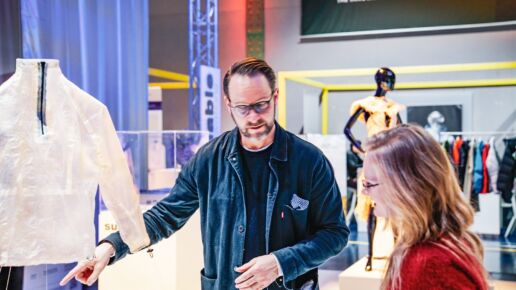
GET INFORMED & INSPIRED AT THE MUNICH FABRIC START
IN THE SUSTAINABLE INNOVATIONS AREA AT KEYHOUSE – H5!
Discover more industry-changing innovations at our upcoming trade shows:
100 % collagen, 0 % plastic - Sustainable innovations
100 % collagen, 0 % plastic
GOLD by WINT Design Lab Robin Hoske and Felix Rasehorn
Sustainable Innovations
If you think that “GOLD” by WINT Design Lab was inspired by the shiny precious metal, you’re wrong – the design research project draws its inspiration from the outer tissue layer of the cow’s intestine. This extremely thin, elastic and tear-resistant membrane, also called gold beater’s skin, was used in the past as a separating layer when beating gold leaf.
Product designers Robin Hoske and Felix Rasehorn, founders of WINT Design Lab, together with Mimotype Technologies, saw the potential in the material to create durable and recyclable high-performance textiles free of plastic.
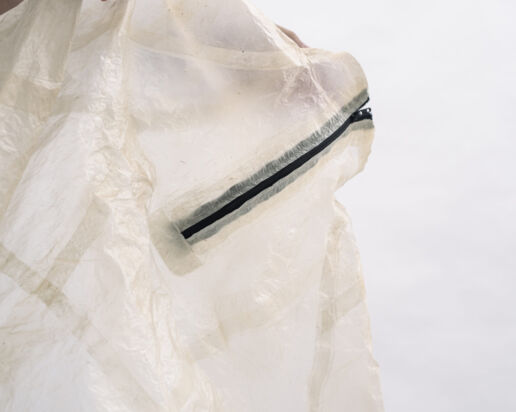
Animal skins, due to their properties, have been used by humans throughout history to create textiles with water-repellent capabilities. During a one-year research fellowship, WINT therefore investigated the aesthetic and functional design features of the skin of the goldbeater and sequenced the RNA. The goal: to synthetically replicate the material properties, develop a biopolymer and use it to make high- performance textiles. In cooperation with Mimotype
Technologies, a biotech start-up from Berlin, and funded by the BIOTEXFUTURE project of the ITA Institute of Textile Technology, the researchers succeeded in cultivating the unique material in bioreactors. The result is bio-synthetically grown collagen substrate – vegan and biodegradable – from which WINT has reated a running jacket that meets both aesthetic and functional demands.
While the global demand for synthetic textiles continues to rise and their production consumes large amounts of petrochemicals, energy and finite raw materials, a new generation of water-repellent outdoor jackets is thus born.
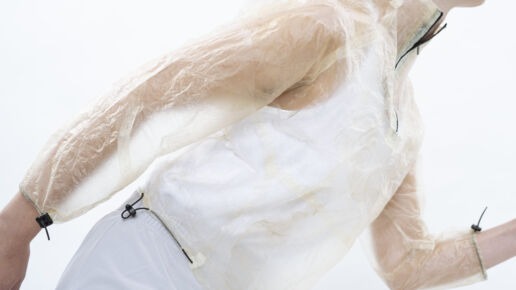
Source: GOLD
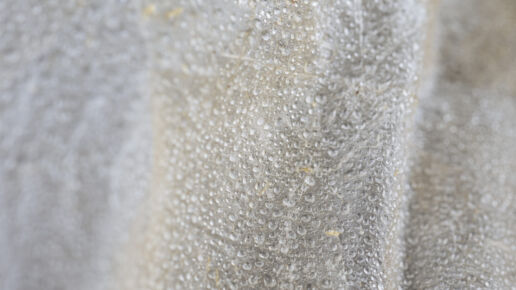
Source: GOLD
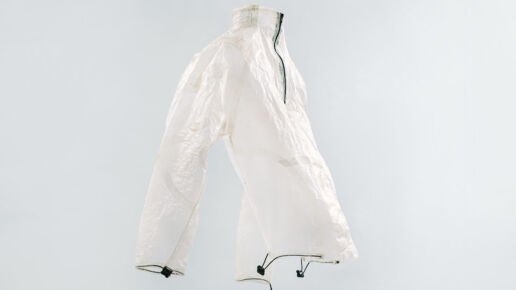
Source: GOLD
“As designers we have to shift the reasoning of our practice from convenience to impact.”
———————————————————————–
THIS MIGHT BE ALSO INTERESTING FOR YOU:
Navigating the Future of Sustainable Innovation
3. September 2024
This season, we're continuing this saga by posing critical questions and embracing a more holistic narrative. It’s less about solutions and more about interventions and transformative thinking.
INTUITION – In conversation with the organisers of MUNICH FABRIC START about the zeitgeist, trade shows and new chances
3. September 2024
INTUITION means that we have the courage to rely on our inner voice instead of just relying on hard facts and data. An interview with the organisers of MUNICH FABRIC START.
FABRIC HIGHLIGHTS & MATERIAL NOVELTIES FOR AUTUMN.WINTER 25/26 – PART VIII
3. September 2024
The claim “The best made by our hands” highlight the importance of our partners to create an high quality fabric giving the best service possible.
Let's get circular - Sustainable innovations
Using existing resources and creating something new from them: What if you didn’t dispose of the leftovers of freshly squeezed juice – but could create a new material from it? Germany is at the forefront of apple juice consumption, producing up to 200,000 tonnes of pomace per year, solid residues from the pressing process. Instead of reusing them, as has been the case up to now, mainly in biogas plants, for pectin extraction or as animal feed, textile and surface designer Verena Brom has been inspired to develop new material systems for various industries.
The designer studied at the Weißensee Art Academy in Berlin. In the project “A Matter of Fruit“, she produces various biodegradable films from pomace residues that can be used instead of synthetic material. Visually and characteristically, it can be classified as a paper, plastic or leather alternative, depending on its thickness, and offers potential for different areas of application – from interior design to the clothing industry. The material is suitable for laser cutting and engraving, but due to its fusibility it can also be welded or pressed into shape. In addition to the films, Verena Brom has developed a printing paste made from apple pomace that further expands the material’s design possibilities and areas of application.
After the first cycle of use, the material can be returned to the natural loop: For example, it can be turned into a plant pot that biologically decomposes after being potted into the soil. This brings Verena Brohm closer to her goal of using renewable resources – such as the by-products of the food industry – and to use design as a tool to optimise material cycles.
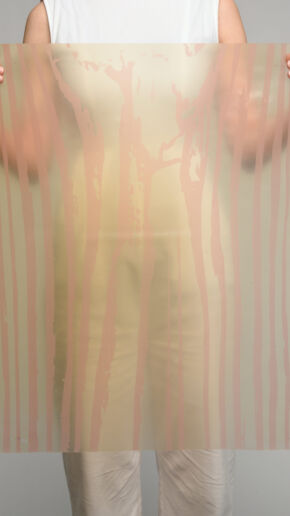
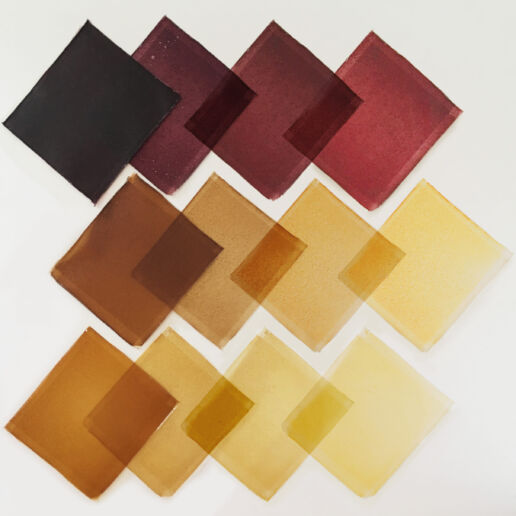
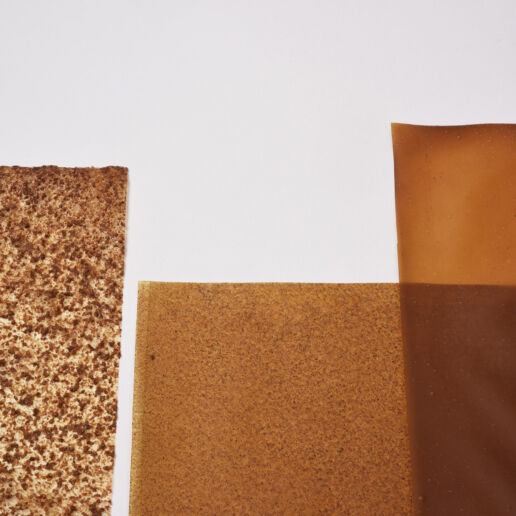
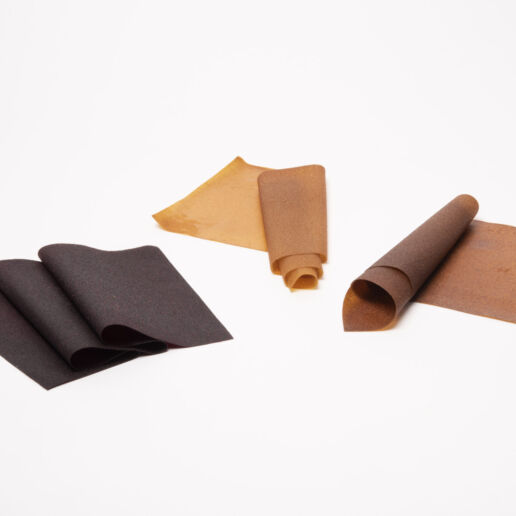
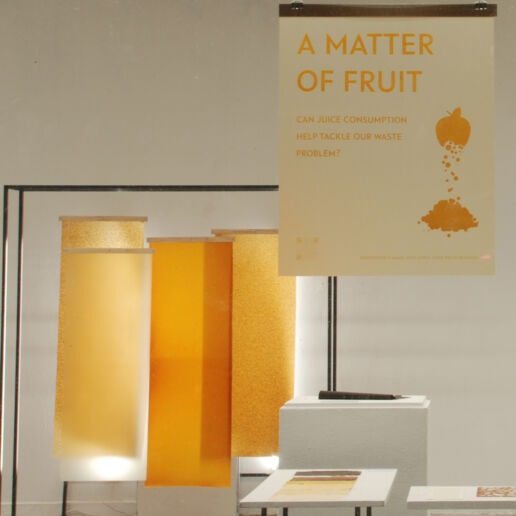
“When developing the material, it was important to use as few additives as possible – and to push boundaries:
how can different properties be developed solely through different processing methods? Using different techniques can expand the
scope for design and influences the haptic and translucency of the material:
from smooth to abrasive, from transparent to opaque – a big variety of options are possible without loosing the mono-materiality.“
———————————————————————–
THIS MIGHT BE ALSO INTERESTING FOR YOU:
Navigating the Future of Sustainable Innovation
3. September 2024
This season, we're continuing this saga by posing critical questions and embracing a more holistic narrative. It’s less about solutions and more about interventions and transformative thinking.
INTUITION – In conversation with the organisers of MUNICH FABRIC START about the zeitgeist, trade shows and new chances
3. September 2024
INTUITION means that we have the courage to rely on our inner voice instead of just relying on hard facts and data. An interview with the organisers of MUNICH FABRIC START.
FABRIC HIGHLIGHTS & MATERIAL NOVELTIES FOR AUTUMN.WINTER 25/26 – PART VIII
3. September 2024
The claim “The best made by our hands” highlight the importance of our partners to create an high quality fabric giving the best service possible.
The New World of Colours - Sustainable innovations
THE NEW WORLD OF colours
MycoColors by Birke Weber and Friederike Hoberg
SUSTAINABLE INNOVATIONS
Dyes play a major role in our daily lives – in the clothes we wear, the cosmetics we use or the food we eat. Most of the dyes we use are of synthetic origin, which poses potential health risks – both in the manufacturing process and in the dyeing process or use. In addition, dyes and pigments in industrial wastewater are not infrequently released into the environment, where they remain and damage ecosystems.
MycoColors, a project by designer Birke Weber and biochemist Friederike Hoberg, addresses precisely this problem. The two are researching the potential of alternative dyes – specifically: from fungi. With MycoColors, they want to develop optimal growth conditions for colour-producing mycelium with the aim of creating a sustainable extraction of dyes and an innovative dyeing process and establishing fungal dyes in the textile and fashion industry. Because: fungi offer a lively, broad colour spectrum that runs through all the colours of the rainbow and is far from being exhausted
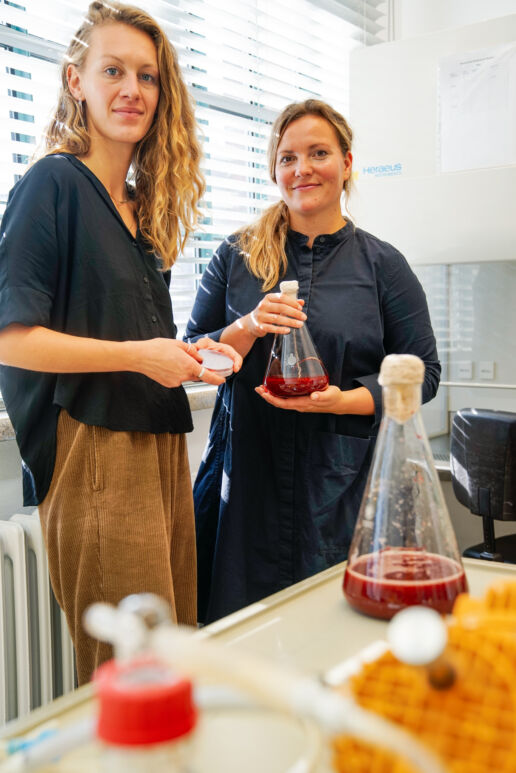

The advantages: The fungal mycelium from which the dyes are extracted grows within just a few days, cultivation takes place in inexpensive culture mediums and production is independent of weather and season. Furthermore, MycoColors works in a closed material cycle: resources such as water and nutrients can be recovered and reused, and by-products such as the biodegradable mycelium can either be returned to nature or upcycled – for example, by using it for paper production.
“The textile and fashion industry uses vast quantities of toxic and carcinogenic chemicals, including synthetic dyes, for its ever-changing
product range. But the end customers cannot trace everything that is hidden in a purchased T-shirt or carpet. A humane and environmentally
friendly alternative made from fungi aims to revise this uncertainty, especially with regard to the colors in a purchased product.”
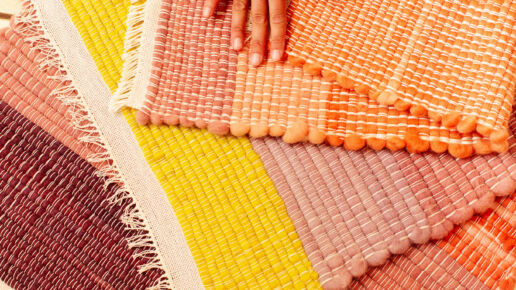
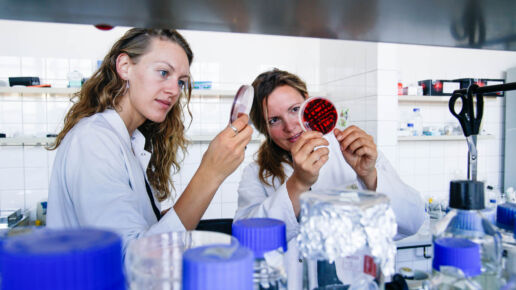
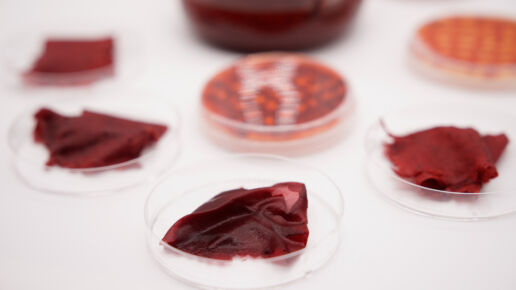
———————————————————————–
THIS MIGHT BE ALSO INTERESTING FOR YOU
Navigating the Future of Sustainable Innovation
3. September 2024
This season, we're continuing this saga by posing critical questions and embracing a more holistic narrative. It’s less about solutions and more about interventions and transformative thinking.
INTUITION – In conversation with the organisers of MUNICH FABRIC START about the zeitgeist, trade shows and new chances
3. September 2024
INTUITION means that we have the courage to rely on our inner voice instead of just relying on hard facts and data. An interview with the organisers of MUNICH FABRIC START.
FABRIC HIGHLIGHTS & MATERIAL NOVELTIES FOR AUTUMN.WINTER 25/26 – PART VIII
3. September 2024
The claim “The best made by our hands” highlight the importance of our partners to create an high quality fabric giving the best service possible.
Collective braiding - Sustainable innovations
A world where everything is becoming faster, more connected and more digital, endless possibilities are emerging. But why always strive for the new instead of continuing the traditional?
Designer Camille Champion has taken note of this development and, during a stay in South Korea, set out to revive interest in traditional craftsmanship.
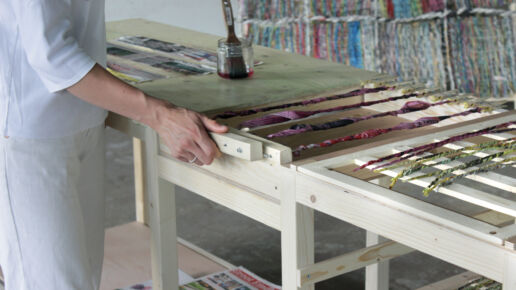
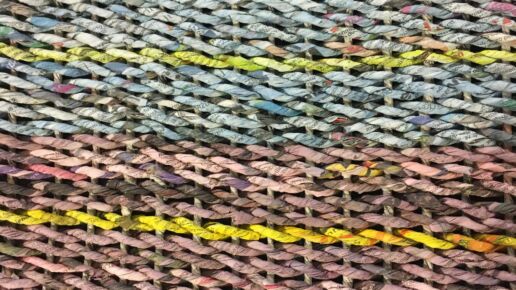
During her travels, she discovered the over 500-year-old technique of jiseung – a process dating back to the Joseon Dynasty that is used to make basketry from old books and paper waste. To do this, the paper is cut into thin strips and then corded. The cords can then be woven into containers such as baskets in various colours and patterns using different basketry techniques.
To save this cultural heritage from extinction, Camille Champion has launched the “Twist and Roll” project, bringing the reuse of newspaper waste to create new objects into a modern Western context: to pass on the craft, the designer has set up a series of workshops to give school children a connection to this tradition. She has designed a small weaving tutorial to teach children to make their own paper threads, weave them on a loom and then collectively build a tent-like structure for their classroom. Twist and Roll combines sustainability, creativity, craft skills and teamwork to show how the education system can benefit from crafts.
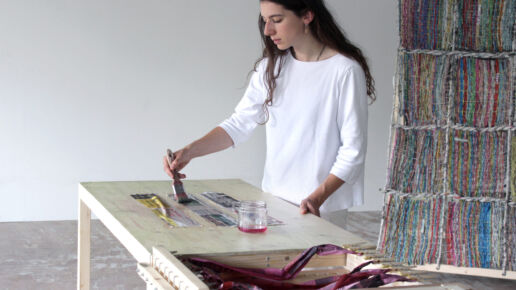
“In my opinion, giving the right tools to the new generations is very important.
Teaching them about materiality, history, or sustainability, will allow them to make the right choices for a better future.”
———————————————————————–
THIS MIGTH BE ALSO INTERESTING FOR YOU
Navigating the Future of Sustainable Innovation
3. September 2024
This season, we're continuing this saga by posing critical questions and embracing a more holistic narrative. It’s less about solutions and more about interventions and transformative thinking.
INTUITION – In conversation with the organisers of MUNICH FABRIC START about the zeitgeist, trade shows and new chances
3. September 2024
INTUITION means that we have the courage to rely on our inner voice instead of just relying on hard facts and data. An interview with the organisers of MUNICH FABRIC START.
FABRIC HIGHLIGHTS & MATERIAL NOVELTIES FOR AUTUMN.WINTER 25/26 – PART VIII
3. September 2024
The claim “The best made by our hands” highlight the importance of our partners to create an high quality fabric giving the best service possible.



